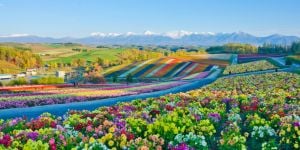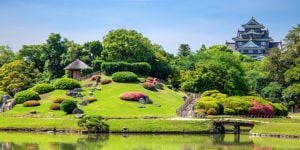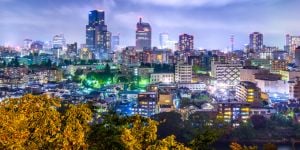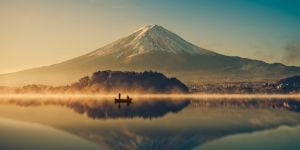
You're in Japan, leaving Tokyo, the megalopolis capital, behind and moving further south, towards Hiroshima. You are looking for accommodation, wondering what to choose between a room in a guesthouse/shared house and an apartment. Which town to choose? Here's a practical guide to finding accommodation in Hiroshima.
Living in Hiroshima: the prefecture or the city?
Before focusing on the housing offers in Hiroshima, you're advised to get familiar with some geographical facts. Hiroshima prefecture is located southwest of Honshu, Japan's main island. Japan is an archipelago with five main islands: Hokkaido in the North, Honshu, Shikoku, Kyushu, and Okinawa in the South. In addition to these five main islands, there are many islands and islets, some inhabited, some not, but let's get back to Hiroshima.
The Hiroshima prefecture faces the island of Shikoku. It is bordered by four other prefectures: Okayawa in the East, Tottori in the Northeast, Shimane in the North, and Yamaguchi in the Southwest. Hiroshima, separated from Shikoku Island by the Seto Inland Sea, is home to 2,737,070 inhabitants as of December 1, 2023. Among them, 2,677,533 are Japanese residents, and 59,537 are foreigners. Most of the population resides in Hiroshima City, which has a population of 1,184,895. Hiroshima City is also the capital of the prefecture.
So you can live in Hiroshima Prefecture or the capital city, Hiroshima. It's all up to you.
Other important cities of the prefecture
The second biggest city is Fukuyama, located in the Southeastern part of the territory, not far from the border with Okayama Prefecture. It is home to 452,288 inhabitants as of November 1, 2023, far from about 1.2 million in Hiroshima.
The coastal city of Kure lies in the Southwest and has 201,563 inhabitants. Higashi-Hiroshima, located in the South of the prefecture, has a population of 198,252. The remaining cities have populations ranging from 22,000 to 125,000. The prefecture is divided into districts: Aki in the South, Jinseki in the Northeast, Sera in the center, Toyota in the South, and Yamagata in the Northwest (source: Estimated population in Hiroshima).
Districts of Hiroshima City
Let's close up on the city of Hiroshima. In this guide, we will mainly focus on the capital city, which is the economic heart of the prefecture. Hiroshima City is divided into eight districts or wards ("ku" in Japanese): Naka, Higashi, Minami, Nishi, Asa Minami, Asa Kita, Aki, and Saeki.
Asakita-ku, in the North, is the biggest district but is not the most populated, with 134,693 people living there as of November 1, 2023. On the other hand, 245,471 people prefer to live in the most populated district, Asaminami-ku, which is located just below Asakita-ku.
Nishi-ku (the western district) is south of Asaminami and home to 186,902 people. Then comes Minami-ku (the southern district), with its 144,161 inhabitants. In between, you will find Naka-ku (central district) with 143,051 inhabitants.
East of Nishi-ku lies the Saeki-ku, with 139,303 inhabitants. Southeast of Asakita, Higashi-ku has a population of 117,020. The last borough, Aki, is located south of Higashi-ku and borders the Minami district. Aki-ku has a population of 74,314 (source: Estimated population in Hiroshima).
If you want to live closer to the city center and enjoy an urban ambiance, Asaminami-ku, Nishi-ku, and Minami-ku are the perfect choices. On the other hand, if you prefer quieter and less populated areas, Aki-ku and Higashi-ku will suit you better.
It is vital to take the time to understand how the Japanese territories are divided administratively. It is not necessary to know everything on the tip of your fingers. It's just a matter of grasping the way Hiroshima prefecture and city are divided to understand better where to look for a place to live.
Good to know:
"Kita" means "North", "Minami" means "South", "asa" means "morning", or East if you prefer.
City of Hiroshima
Motomachi, Naka-ku
The Naka Ward in Hiroshima City is known as the city's heart. Tourists are often advised to book a hotel room in Motomachi, Naka-ku. This is where the Hiroshima Castle and the Peace Memorial are located. Other prestigious sites, museums, and cultural properties are in Motomachi or the surrounding area. On a different note, Motomachi shopping street is, as its name may suggest, entirely dedicated to shopping, emphasizing design items, decoration, and souvenirs.
Nakamachi, Naka-ku
We are still in Naka-ku, and Nakamichi is the most remarkable area of the city, with bars, attractions, clubs, and restaurants. The area is dynamic and cool, with a particularly active night scene. However, this does not affect the quietness; quite the contrary. Nakamachi has it both ways and is suitable for night owls and those looking for peace and quiet.
Hijiyamahonmachi, Minami-ku
Let's now head for Minami-ku. If you go to Hijiyamahonmachi, you will discover a green area. Hijiyamahonmachi is one of the city's greenest places, with parks, running paths, and everything to satisfy joggers, walkers, and families. The place is also known for being family-friendly. This is good to see if you plan to move to this neighborhood with your family.
Hiroshima Prefecture
Fancy the countryside? Let's take a look at Hiroshima Prefecture and reconnect with nature. Akiota is a small town in Yamagata, Northwest of the prefecture. People are drawn to it because of its peaceful environment, which makes it ideal for raising children. In fact, the town boasts of its infrastructure and its child-friendly environment.
Shobara, the hidden village in the north of the prefecture, is one of the oldest villages in Japan. Its inhabitants live in harmony with nature. The village's beauty and authenticity are due to its rich and preserved nature.
In 2024, recent news states that the government plans to introduce a policy during the regular Diet session. This policy aims to assist in creating independent organizations known as “rural regional management organizations” in the hilly and mountainous areas of Hiroshima Prefecture. The government proposes this as part of revising the Basic Law of Agricultural Policy. Shobara City in northern Hiroshima Prefecture serves as a model for this initiative.
Types of accommodation in Hiroshima
Whatever country you live in, choosing your accommodation is an adventure and an investment. Before considering home decor, some questions must be asked, like:
- How long will you be in the area (in this case, in the prefecture or city of Hiroshima)?
- What is the purpose of your trip?
- Are you an expat on a job contract and intend to leave after completing your tasks?
- Are you an immigrant who is settling down for a very long time, or even for their whole life, or are you just a short-term visitor, a business traveler?
- What is your budget?
- Are you looking for a job, or have you already found one?
- What are your needs?
- Do you prefer the city or the country?
- Do you need to adapt accessibility to your home, for a wheelchair or medical bed, for example?
The answers to these questions will allow you to refine your search better.
The different home configurations in Japan
This small list will be handy for your accommodation search. In Japan, the different home configurations are referred to with the following labels:
- Number (1): indicates the number of bedrooms;
- Letter R (room): means a room;
- Letter L (living room): refers to the living room;
- Letter D (dining room): refers to the dining room;
- Letter K (kitchen): refers to the kitchen.
For example, you will find ads that read: "1LDK", "1R", and "2LDK".
- 1LDK means that the accommodation has one bedroom (number 1) and the living room/dining room/kitchen combination;
- 1R is the smallest accommodation one can find and offers only one bedroom. This offer can be attractive, especially if you want a small studio or a shared house. You have your own room and common shared areas, including toilets, bathrooms, kitchen, and living room;
- 2LDK means the accommodation has two bedrooms and a combination of living room, dining room, and kitchen.
How to measure the area of your home in Japan?
In Hiroshima, as elsewhere, downtown housing tends to be more expensive than suburban accommodation. The area is also a factor. For the same price, you can get a small apartment in the heart of the city, a larger apartment, or even a house in a rural area, but how do we measure the size of a property in Japan?
Traditionally, the surface area is measured in a unit called "jo". This is the size of a tatami mat. Traditional Japanese homes usually have at least one room with an entire floor made of tatami (a traditional Japanese carpet used for flooring).
1 jo is about 1.62 m². For example, a room of 7 Jo = 11.34 m², but you'll see that most ads have adopted the universal counting system, in m² that is. So don't panic. You will have no trouble deciphering the surface area of your home.
However, pay close attention to that, especially if you choose a tiny apartment. You could end up with a small room of 5 m². This type of advertisement is more common in Tokyo, where the population density is much higher than in Hiroshima.
Rent prices in Hiroshima
Apartments
In Japan, apartments are called "apa-to" or "mansions". The price varies depending on the location in the city, the area you choose to rent, the type of accommodation, the square area, building age, with or without utilities, etc.
In Higashihiroshima, for example, you can find 54m² 3DK for about 24,000 yen monthly in Takehara City. In downtown Hiroshima, prices can go up to 50,000 or 70,000 yen per month, but you can also find very good deals in Hiroshima City, such as a 54m² 2LDK that includes two bedrooms, one living room, dining room, and kitchen combo, for 55,000 yen per month.
Keep in mind that these are only average estimates. Prices can vary by as much as double depending on the property type you are looking for and your search area. Also, remember that the price ranges presented below are for unfurnished properties, which is often the case in Japan, but prices may also come with or without utilities. You may also need to pay a guarantee. For a good deal in Hiroshima, especially in the Nishi district, expect a deposit of about 140,000 yen, which is refundable (source: Apartment costs in Hiroshima).
Houses
The price for houses can vary according to many criteria, including the surface area, having a garage/garden/balcony, the number of bedrooms, etc. For example, you can find a 95m² 5DK (5 bedrooms, dining room, and kitchen) with a parking lot in Asakita-ku (Hiroshima City) for about 59,000 yen per month.
Studios and sharehouses
The same logic applies to renting a small studio or a room in a sharedhouse or guesthouse. In the south of Hiroshima city, you can find a room in a sharehouse for about 50,000 yen per month. Prices will vary according to the location of the residence and the options it offers, such as bicycle parking, laundry room, coworking space, unit sizes, and so on.
Hotel or “ryôkan”
Visiting Hiroshima and wanting to stay in a hotel or a “ryôkan” (traditional Japanese inn)? Here again, prices will vary according to the standard you seek. You can expect to pay more than one and a half million yen for a one-month stay in a luxury “ryôkan” in Miyajima. A cheap hotel in Hiroshima costs around 70,000 yen per month. Once again, depending on your criteria, you can find more or less expensive hotels.
How to find accommodation in Hiroshima
Finding a real estate agency
Whether you choose a traditional real estate agency or one that specializes in dealing with foreigners, you will find the same search options on their websites, namely by price, year of construction, ease of access to metro/train station, surface area, agency fees, facilities and services available like parking, bicycle parking, courtyard, laundry room, etc. Some websites also filter your search by whether or not a property accepts pets. In Japan, checking the details of your rental contract before adopting a pet is better. Many accommodations still do not allow dogs, cats, and other pets.
Traditional real estate agencies
In Japanese, a real estate agency is called "fudôsanya". The real estate agent is the "fudôsan". To start your search, consider real estate agency websites like Fudosan Honpo or Daiwa Kosan. Unfortunately, these websites do not have an English version. You might also want to look around the area/city where you want to live. Most likely, several local agencies can help you narrow your search. Then again, there is little chance that they will speak English. Hence, you would need to speak Japanese.
Agencies that specialize in renting to foreigners
GaijinPot, Village House, Apartment Japan, Wagaya Japan, Japanese guesthouses, etc., are among the many agencies renting or selling to foreigners. In general, their websites are in English and sometimes offer multilingual versions. Within the agency itself, you may find a multilingual staff. This is the case, for instance, with Fontana Tokyo Apartment or OAK house, but neither of these agencies offers real estate in Hiroshima prefecture.
Buying property in Japan
If you wonder whether a foreigner can buy a house or an apartment in Japan, the answer is yes. You may even qualify for a loan, depending on your visa. There are several options available.
In Japan, individual houses are called "ikkodate". If you want to build your own home, you can go to a "housemaker", a real estate agency specializing in custom-made houses. You can also choose to buy a new house or an old one.
However, you cannot apply for a loan with a Japanese tourist visa, student visa, or work permit. You will need a work or permanent residence visa. The longer the duration of your visa, the more confident the banks are. Of course, they will also consider your salary, starting capital, and repayment ability.
Tips for choosing accommodation in Japan
Whether you have chosen Hiroshima or another region of Japan, be careful about the condition of your property. Ancient houses are, not surprisingly, much cheaper, but they may not be earthquake-proof. The same caution applies to homes below sea level, on the seashore; some areas are sometimes flooded during the rainy season.
Formerly a significant importer of asbestos, Japan only completely banned this product in 2012. If you buy or rent a property built before that year, check if it is asbestos-free. The information does not always appear on the agencies' websites.
If possible, visit your future neighborhood at different times of the day.
Useful links:
Websites in English:
Websites in Japanese:
We do our best to provide accurate and up to date information. However, if you have noticed any inaccuracies in this article, please let us know in the comments section below.








